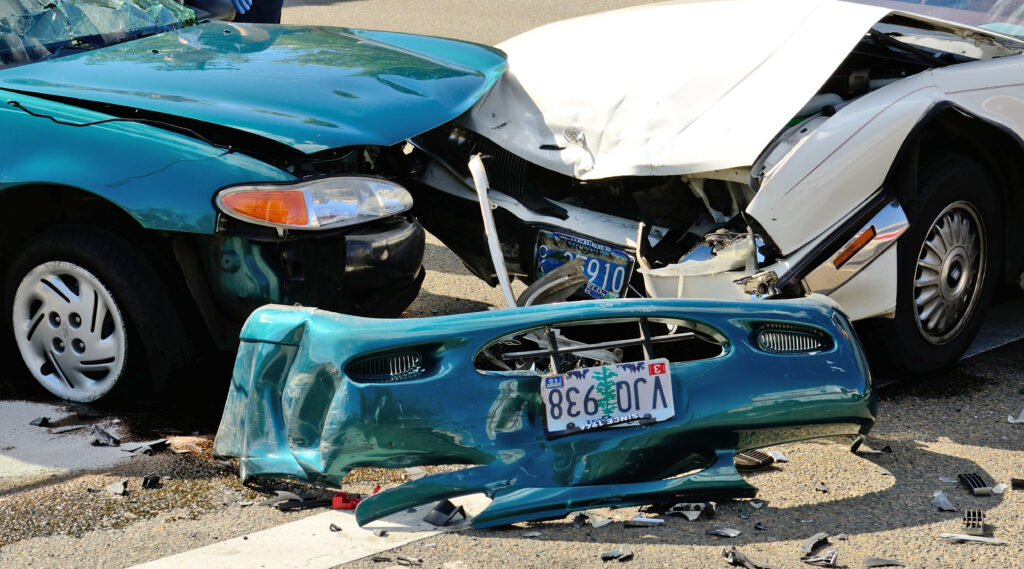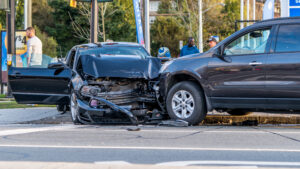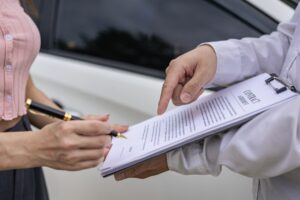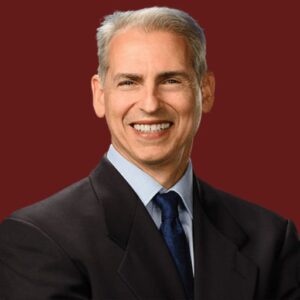
Did another vehicle slam into you in an intersection? Do you have pain in your back, neck, arm, or other part of your body? If another driver was at fault in the intersection crash, you may have the right to receive compensation in a personal injury claim. This post will teach you more about intersection accidents and injuries and how to handle your claim. A Bakersfield Car accident attorney in your area can answer any specific questions.
Intersection Accident Facts And Statistics
Intersections are necessary for our road system, but many auto accidents happen when roads intersect. The Federal Highway Administration states that there were 11,799 traffic fatalities at intersections in the United States in a single year. Other sobering intersection facts and statistics include:
- The NHTSA reports that 40 percent of all auto accidents happen at intersections.
- The NHTSA states that 97 percent of intersection accidents happen because of driver distraction or inattention.
- 20 percent of fatal auto accidents happen at intersections.
- About 165,000 accidents happen annually at intersections because of red-light runners.
You should receive immediate medical attention if someone hits you at an intersection. Doing so protects your health and your future injury claim. Then, have your case reviewed by a seasoned car accident attorney.
How Do Intersection Accidents Happen?

Why do so many serious crashes happen at intersections? These mishaps usually occur when vehicles come into conflict with one another. In almost every case, an accident can occur when one driver doesn’t provide the right of way to the other driver as required. Whether the driver was distracted, inattentive, or trying to beat a traffic light, the result is often the same: a serious intersection auto accident.
Some of the ways that intersection accidents happen include:
- A car makes a right turn. Many US intersections allow vehicles to make a right turn on red. However, the turning driver must usually give the right of way to other traffic. The turning driver may ignore oncoming traffic from the left and turn anyway, which can trigger a serious side impact or other type of collision.
- A car ignores a traffic signal while going straight. Every driver is required to stop fully at a red light or stop sign, but a driver can be distracted by a cell phone or attempt to beat the red light, causing a high-speed intersection accident.
- A car makes a left turn. Cars can usually turn left in an intersection when oncoming traffic has cleared. But drivers turning left must yield to drivers going straight unless there is a green arrow. The driver turning left may misjudge oncoming traffic or not see it.
Most intersection accidents occur because one driver is at fault and didn’t yield the right way. An experienced car accident attorney can review your case and determine who was at fault. If the other driver caused the intersection crash, you can receive compensation in a personal injury claim.
Where Do Intersection Accidents Occur?
There are various types of intersections in the US. These are where most intersection car crashes happen:
- Four-way intersections comprise approximately 16 percent of all intersection crashes.
- T-intersections comprise about 13.55 percent of intersection crashes.
- Y-intersections make up about 1.1 percent of intersection accidents.
- Five-point intersections make up about .4 percent of all intersection crashes.
- Roundabouts comprise about .13 percent of all intersection accidents.
- Traffic circles account for about .08 percent of all intersection crashes.
Naturally, four-way intersections are the site of most crashes in intersections. These intersections are the most numerous in American communities.
Common Intersection Accident Injuries
Intersection crashes are often serious and may trigger multiple serious injuries, including:
- Head injuries: A head injury may happen when your head strikes the window, windshield, steering wheel, or dashboard. Or, the force of the crash can cause the brain to bounce inside the skull, which may cause bleeding or a concussion.
- Amputations: The loss of an arm, leg, hand, or foot can leave you permanently disabled.
- Whiplash: Injuries to the soft tissues in the neck may take months to heal.
- Internal bleeding: The violent force in the intersection crash can damage delicate internal organs and tissues.
- Spine and back injuries: You can pull muscles and ligaments, rupture a disc, or suffer vertebrae or spinal cord damage.
- Burns: High-speed intersection crashes can rupture the fuel tank and lead to severe burns.
- Cuts and scrapes: Broken glass, metal, and plastic can tear through your body and cause long-term disfigurement and scarring.
Common Types Of Intersection Accidents
There are several types of common accidents in intersection crashes:
Angled Accidents
Crashes at an angle are often almost as common as single-vehicle crashes in intersections. Typically, one vehicle will not provide the right of way to the other driver, causing a side-impact or T-bone crash. T-bone accidents can be especially hazardous because of the lack of protection offered by the side of most vehicles. Most vehicles have side-impact airbags today, but car doors are relatively thin and absorb little impact. In a side impact crash, passengers on the impact side of the automobile can sustain particularly severe injuries.
Rear-End Crashes
Rear-end crashes are common in intersections throughout the country. They usually happen because the rear driver is distracted or trying to beat a red light and rear-ends a stopped vehicle. The rear driver may also misjudge how far it is to the next vehicle. Tailgating is another common cause.
Pedestrian Accidents
Intersection accidents can cause serious injuries to drivers, passengers, pedestrians, and cyclists. Pedestrians are especially at risk of being hit in intersections. While pedestrians usually have the right of way in crosswalks, a reckless driver may not yield and can hit them. Pedestrian accidents are usually serious; you should always retain a car accident attorney if you suffer an injury.
Sideswipe Crashes
A sideswipe accident usually happens when one vehicle glances off the other when passing in the opposite direction. Sideswipe accidents also happen when vehicles are going in the same direction. Sideswipe accidents can occur in intersections if a driver drifts over the solid yellow line close to oncoming traffic.
Head-On Crashes
Head-on crashes are fairly uncommon but among the deadliest of all intersection accidents. They usually happen because another driver is distracted, intoxicated, speeding, or texting and drifts into oncoming traffic. Fault can often be disputed in head-on accidents, so speak to a lawyer promptly.
Determining Fault In An Intersection Accident
Whether you receive compensation in a claim or lawsuit boils down to one thing: Can your attorney prove that another driver violated their duty of care and injured you? Determining liability in an intersection auto accident can be straightforward, but it also can be complicated. One or more parties will likely contest that they were at fault for the crash.
When two drivers approach an intersection, one usually must yield to the other. Drivers are generally required to exercise a duty of care and yield the right of way to other vehicles and pedestrians when they must do so according to traffic laws. For instance, a vehicle turning left in an intersection usually must yield the right of way to oncoming traffic. Failure to yield can cause an accident and put the driver at fault for the collision
Establishing a duty of care in an intersection accident requires your lawyer to collect important evidence to prove these points:
- Another party was driving in the intersection and had a duty of care. Drivers in the US are required to observe traffic rules and not injure other motorists or pedestrians on public roads.
- The other driver entered the intersection and violated their duty of care. For example, when you had the right of way, another driver turned left in front of you.
- The accident caused your injuries. Using the above example, you may have T-boned the other vehicle when it turned left, causing you to break multiple bones.
- The accident and injuries caused compensable damages, such as medical bills and loss of income.
Your attorney will rely on accident evidence to prove another driver violated their duty of care and injured you. Sometimes, the other driver will obviously be at fault, and their insurance company will accept liability and settle quickly. On the other hand, their attorney may contest liability or even partially blame you for the crash. That’s why it’s critical to have a seasoned, aggressive personal injury attorney advocating for you as soon as possible.
Do You Need A Car Accident Lawyer For An Intersection Accident Claim?

It isn’t required, but it’s usually best. These accidents are often serious, with substantial injuries, property damage, and medical bills. An auto accident attorney will determine who was at fault and hold them accountable for their actions. They also will correctly value your claim, accounting for the full amount of your medical expenses, future medical needs, lost earnings today and in the future, and pain and suffering. Your attorney will do the following to prove your case and hold the defendant liable for their negligence:
- Obtain the police report from the responding officer. The police report cannot serve as evidence in court. However, it can provide important information regarding how the accident may have happened and be important evidence for the at-fault driver’s insurance company to consider.
- Collect evidence to support your car accident claim, such as photographs and videos of the accident scene and vehicles, medical reports, surveillance video, and eyewitness testimony. If distracted driving occurred, an attorney can obtain cell phone records to determine if the individual was texting and driving.
- Prove the defendant was negligent according to the facts of the intersection accident.
- Negotiate with the at-fault driver’s insurance provider.
- After sending an insurance demand letter, determine a fair settlement value for your case and push for the most compensation.
- If settlement negotiations fail, your attorney will present your case to a judge or jury.
Your attorney will be your tireless advocate and legal guide during a stressful time of your life. Most intersection accident victims are glad they hired an attorney to handle all the legal and administrative issues of a serious accident claim. Furthermore, they usually receive more compensation in a settlement than they might have without legal assistance.
Don’t Damage Your Intersection Accident Claim
Many intersection crashes are the fault of another driver. For example, if a driver rear-ends you at a busy intersection stop light, it’s fairly obvious they caused the crash. Your claim can still take an unexpected turn, resulting in less compensation than anticipated. This may occur if you take actions that harm your claim. Make sure you don’t do any of the following after your intersection crash:
- Delay going to the doctor: Many accident victims don’t want to go immediately. You may be certain that you aren’t hurt, so why bother with the hassle of medical attention? Because without a doctor’s statement identifying your injuries, it can become more complicated to make a valid claim later. Delaying medical attention for a few days can compromise your accident claim. To be safe, have yourself checked out by your doctor within 24 hours.
- Not hiring a lawyer: Most intersection crash victims don’t understand the value of their case. You’re likely entitled to more than just medical expenses; a severe injury can leave where you cannot work for months, necessitating rehabilitation. Only an experienced car accident attorney understands the full value you may be due.
- Admitting fault: You might feel inclined to apologize or admit fault when another car hits you. Don’t! Tell the other driver as little as possible and contact an attorney immediately.
Contact An Experienced Car Accident Attorney Today

Mickey Fine, Car Accident Lawyer
Contact an experienced auto accident lawyer today to learn if you have a viable case. Consultations are free with no obligation, so there is no reason not to act today and schedule your case evaluation.
